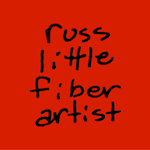Human Marks : Day 5 (final thoughts)
[Edited 5/28, 10:00 PM to correct typos]
I took this photo on a walk after lunch Thursday for both inspiration and memory. It might sound a little precious, but I keep thinking "Rows of corn; rows of stitching." In some way that I don't yet fully understand, that seems to encapsulate this week. One of the things that's really staying with me is the stitching--on fabric, on paper, alone, and in small circles of new friends. Stitch is transformative. It joins fabric into garments to cover and protect out bodies; it decorates functional items; it's a tool for artists. And yet stitch, like weaving, has become mechanized to the point that we hardly give a thought to its presence in our lives.
I have sewing machines that can make 1,500 stitches per minute, and others that sew with 3 or 4 needles at a time. I treasure and rely on these tools to do my work, and I'd hate to be without them. Gosh, I wonder if I even managed to sew 1,500 stitches by hand this week! Not too many generations ago (and still today in some places) hand stitch and hand weaving were more the norm than the exception. Textile, thread, and needles were treasured. Garments were cared for and mended. As a consequence of industrial sewing and weaving, garments have become disposable. We replace rather than mend, and more often than not, we replace out of a desire for the new and chic.
More troubling than our cultural perception of garment and textile as disposable, is our expectation of an unending supply of product at an affordable price. Machine or no machine, someone is making the clothes you wear, even those purchased at a discount store for less than you might spend for lunch. Add to this thought the notion that hand stitched embellishments are time consuming and done entirely by people, not machines.
I feel as though I'm rambling and grasping to draw these thoughts together. It's basically this: Somebody made my clothes, linens, etc. Even if I made some of the clothing, I didn't weave the fabric. Think of all the people involved in the production of a single garment and all of the folks taking their share of the profit. How much money makes it back to the person with his or her hands in the soil or on the sewing machine, or stitching away by hand?
I don't know what to do with that question except to be with it in the hope that greater mindfulness and better stewardship will follow.
It's been wonderful to spend another week at the Barn, to reconnect with a few old friends, and make new connections. Stated simply, Dorothy Caldwell is not only a gifted artist, but a generous teacher. She has a talent for gently moving around the room, connecting with each of her students, and offering suggestions and words of encouragement that seem to keep each person on track--whatever that individual's track might be. Along the way she also interjects thought-provoking ideas, like our discussion and practice of hand stitching, which led to the thoughts above. If you're a visual artist of any sort then I say you can't go wrong with one of Dorothy's classes.

